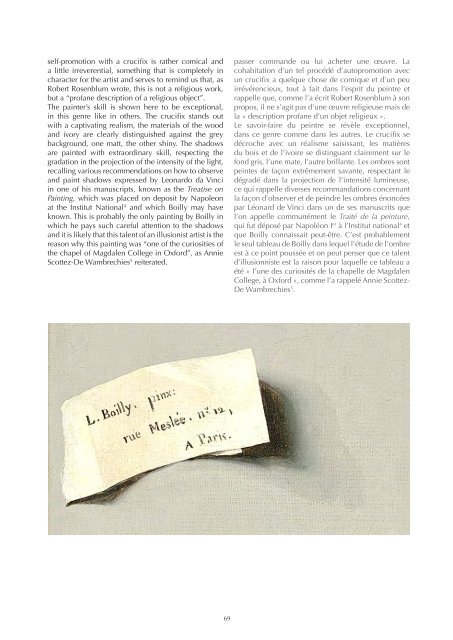XVII - Master Paintings - Jean Luc Baroni and Marty de Cambiaire
Create successful ePaper yourself
Turn your PDF publications into a flip-book with our unique Google optimized e-Paper software.
self-promotion with a crucifix is rather comical <strong>and</strong><br />
a little irreverential, something that is completely in<br />
character for the artist <strong>and</strong> serves to remind us that, as<br />
Robert Rosenblum wrote, this is not a religious work,<br />
but a “profane <strong>de</strong>scription of a religious object”.<br />
The painter’s skill is shown here to be exceptional,<br />
in this genre like in others. The crucifix st<strong>and</strong>s out<br />
with a captivating realism, the materials of the wood<br />
<strong>and</strong> ivory are clearly distinguished against the grey<br />
background, one matt, the other shiny. The shadows<br />
are painted with extraordinary skill, respecting the<br />
gradation in the projection of the intensity of the light,<br />
recalling various recommendations on how to observe<br />
<strong>and</strong> paint shadows expressed by Leonardo da Vinci<br />
in one of his manuscripts, known as the Treatise on<br />
Painting, which was placed on <strong>de</strong>posit by Napoleon<br />
at the Institut National 4 <strong>and</strong> which Boilly may have<br />
known. This is probably the only painting by Boilly in<br />
which he pays such careful attention to the shadows<br />
<strong>and</strong> it is likely that this talent of an illusionist artist is the<br />
reason why this painting was “one of the curiosities of<br />
the chapel of Magdalen College in Oxford”, as Annie<br />
Scottez-De Wambrechies 5 reiterated.<br />
passer comm<strong>and</strong>e ou lui acheter une œuvre. La<br />
cohabitation d’un tel procédé d’autopromotion avec<br />
un crucifix a quelque chose <strong>de</strong> comique et d’un peu<br />
irrévérencieux, tout à fait dans l’esprit du peintre et<br />
rappelle que, comme l’a écrit Robert Rosenblum à son<br />
propos, il ne s’agit pas d’une œuvre religieuse mais <strong>de</strong><br />
la « <strong>de</strong>scription profane d’un objet religieux ».<br />
Le savoir-faire du peintre se révèle exceptionnel,<br />
dans ce genre comme dans les autres. Le crucifix se<br />
décroche avec un réalisme saisissant, les matières<br />
du bois et <strong>de</strong> l’ivoire se distinguant clairement sur le<br />
fond gris, l’une mate, l’autre brillante. Les ombres sont<br />
peintes <strong>de</strong> façon extrêmement savante, respectant le<br />
dégradé dans la projection <strong>de</strong> l’intensité lumineuse,<br />
ce qui rappelle diverses recomm<strong>and</strong>ations concernant<br />
la façon d’observer et <strong>de</strong> peindre les ombres énoncées<br />
par Léonard <strong>de</strong> Vinci dans un <strong>de</strong> ses manuscrits que<br />
l’on appelle communément le Traité <strong>de</strong> la peinture,<br />
qui fut déposé par Napoléon I er à l’Institut national 4 et<br />
que Boilly connaissait peut-être. C’est probablement<br />
le seul tableau <strong>de</strong> Boilly dans lequel l’étu<strong>de</strong> <strong>de</strong> l’ombre<br />
est à ce point poussée et on peut penser que ce talent<br />
d’illusionniste est la raison pour laquelle ce tableau a<br />
été « l’une <strong>de</strong>s curiosités <strong>de</strong> la chapelle <strong>de</strong> Magdalen<br />
College, à Oxford », comme l’a rappelé Annie Scottez-<br />
De Wambrechies 5 .<br />
69















